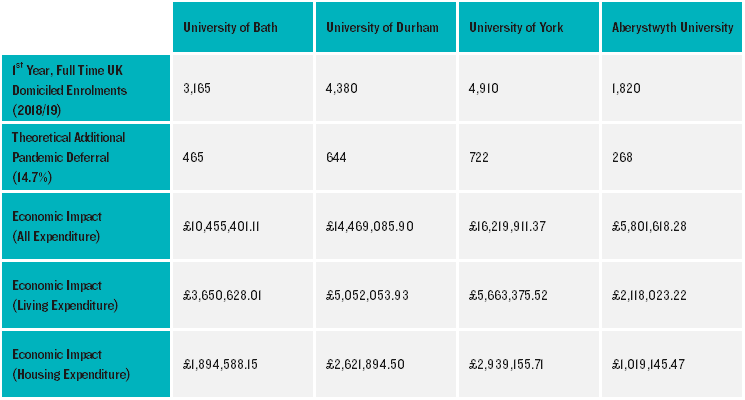I recently
wrote about the impact of COVID-19 on student accommodation given that the traditional university experience is likely to be out of the picture for the short term. I now want to look at some of the other social and economic implications of students not attending university or deciding to study remotely in September 2020.
Impact on student recruitment
There is a real possibility that students will not wish to attend university in 2020/21 due to the fear on missing out on the traditional university experience, that the alternative provision will not provide the same quality of learning, concern about living away from home or because of public health concerns. On a more encouraging note, the Guardian
[1] recently commented that a record 40.5% of all 18-year olds in the UK have applied to go to university in September, the first time that more than four out of ten students had applied by 30 June. It will be interesting to understand the actual registration figures when September comes and how many will be attending in person or studying remotely. The current picture is uncertain.
If 1st year students are not registering for courses and returning students are not attending in person then this has the potential to have huge consequences on towns and cities that depend on students to ensure the vitality and viability of its communities. If learning is going to be online then the need for accommodation as well as other supporting facilities such as shops, pubs and cafes is temporarily reduced.
Aberystwyth, where I completed my undergraduate studies for example is a town that has the university at its heart. For a town with a resident population
[2] of 18,749, the 2011 census states that students accounted for 8,169 of the population. It is also important to note that over 2,000 staff work at the institution
[3], demonstrating the importance of the institution to the social and economic makeup of the town and the surrounding area. There are other towns that are also reliant on the student population. For example, Durham University had 19,025 students
[4] in 2018/19 compared to the resident population of around 43,000
[5]. It also employs over 4,000 people
[6], illustrating its importance to the local area.
A reduction in the number of students learning, living and spending time within these towns could have far reaching consequences on a range of issues such as:
- Impact on services and facilities that rely on the student population such as shops, cafes, pubs and nightclubs;
- Vacancies in student accommodation on campus and in the town centre;
- Loss of jobs at the university and at student focussed businesses;
- Decrease in the vibrancy of the town centre due to lack of a critical mass;
- Less revenue for University provided community facilities such as theatres and art centres;
- Impact on supply chains that normally supply the university.
- Impact on hospitality sector as parents no longer need to visit their children.
Towns like Aberystwyth and likewise York and Bath are likely to be hit even harder as they also rely on tourists to support their functional economy. Tourism is another sector that has been critically impacted by COVID-19 although there are some early signs of a bounceback with people planning on enjoying a staycation during the rest of 2020 instead of venturing abroad.
Economic impact
The economic contribution of students to an university town or city should not be downplayed. The 2014/15 Student Income and Expenditure Survey
[7] (SIES) states that the average (mean) total expenditure including tuition fee costs of full-time English-domiciled students in 2014/15 was £19,922. Adjusted for inflation
[8] this equates to £22,472.41 in 2019 terms.
Within the total expenditure figure, the SIES states that living costs
[9] for full time students domiciled in England averaged £6,956 per annum in 2014/15. Adjusted for inflation this equates to £7,846.51 in 2019 terms. Not all of this spend will be spent locally of course (i.e. utility bills, bank charges and mobile phone charges will be collected centrally). However, a large amount of expenditure will be enjoyed by local businesses (or national businesses with a local presence) including supermarkets, shops, cafes, restaurants and takeaways, pubs and fitness facilities which in turn support local jobs and supply chains.
The SIES states that housing costs
[10] for full time students amounted to an average of £3,610 per annum in 2014/15. Adjusted for inflation this equates to £4,072.15 in 2019 terms. This expenditure will be realised locally, either directly to the university or to private landlords and often re-invested to further improve the housing stock, creating job opportunities in the process.
Taking the above into account it is clear that the economic benefit of students to the university and the university settlement is substantial. Consequential impacts on facilities and services in the towns and cities due to the reduced number of students could therefore give rise to social impacts such as the closing of businesses and the loss of jobs.
Research by London Economics
[11] estimates that the likelihood of deferral amongst UK-domiciled students for 2020/21 was approximately 13.3% if the University was operating as usual (few if any social distancing restrictions or limits to university activities) and 28% if the University was not operating as usual (many classes delivered online and many social distancing restrictions in place). Therefore, the likelihood of deferral amongst UK-domiciled students was approximately 7% higher as a result of the pandemic.
Based on the number of first year full time enrolments in 2018/19 as a proxy we see the following theoretical economic impact, based on a 14.7% deferral rate:
The above does not include an allowance for UK-domiciled part time students or non-UK-domiciled students that may also decide to defer or those that would defer regardless of the pandemic. According to HESA there were 249,080 non-UK-domiciled enrolments studying in UK universities in 2018/19. Given the restrictions and loss of appetite for international travel it is likely that there will be a reduction in international students enrolling in 2020 which will further add to the economic impact on the institutions and the towns/cities that they are based.Source: HESA; Department for Education; London Economics. Note that a different SIES report covers students in Wales and has been used to estimate the Aberystwyth impact.
Key takeaway
The social and economic value of students to the UK’s towns and cities is enormous and is particularly important for smaller towns that are built around the institution. The social and economic impact of a reduction in students is therefore likely to be painful in the short term, especially if these settlements also rely on tourism, another sector that has been impacted by the pandemic.
To assist in ensuring that these university towns and cities are able to survive in the short term it is important to attract as many students as possible and to limit the numbers of deferrals. To do this it will be important to demonstrate that the establishment’s facilities are able to operate as safely as possible given the current circumstances. To this end, Lichfields can provide town planning advice to assist universities on how to rationalise and/or expand its estate to ensure that the university’s offer can be as attractive and as normal as possible during the pandemic. This may mean advising and obtaining planning permission for buildings for alternative purposes, additional temporary or permanent structures, extended opening hours and potentially the need to amend extant planning permissions.
Lichfields has been advising Kingston University on realising its Estate Vision since 2005.Similarly, Local Planning Authorities should be suitably flexible in the short term until student numbers return. This could include fast-tracking the above adaptation planning applications but also allowing town centre units (including accommodation) to be used for different purposes to avoid short term vacancies and designating areas for outdoor socialising so that social events can take place. Lichfields is currently advising a number of Local Authorities on COVID Recovery Strategies. In areas where there is strong tourism demand local authorities should be encouraging temporary changes of use in Student Accommodation to visitor apart-hotel style accommodation.
Contact Lichfields to discuss any planning queries that you may have.
[1] https://www.theguardian.com/education/2020/jul/09/uk-universities-record-number-applications-lockdown[2] 2011 Census (data acquired from Nomis on the built-up area of Aberystwyth)[3] https://www.aber.ac.uk/en/staff-induction/community/[4] https://www.hesa.ac.uk/data-and-analysis/students/where-study[5] https://www.dur.ac.uk/study/location/durham/[6] https://www.dur.ac.uk/about/facts/[7] Department for Education (March 2018)[8] https://www.bankofengland.co.uk/monetary-policy/inflation/inflation-calculator[9] food and drink, personal items such as clothes and mobile phones, entertainment, household goods and non-course travel such as holidays.[10] Including rent, mortgage costs, retainers, council tax and household bills[11] Impact of the COVID-19 pandemic on university deferral rates and student switching – May 2020




